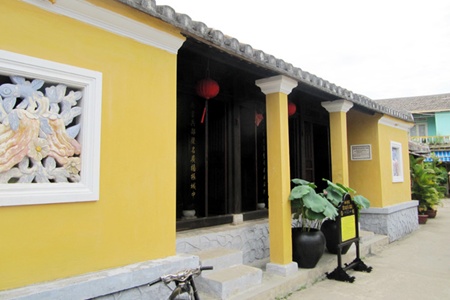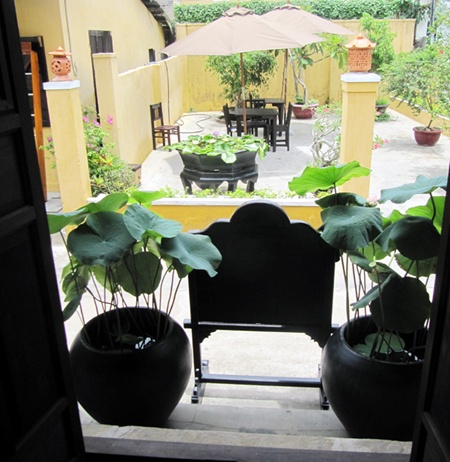Situated in a narrow alley on Nguyen Thi Minh Khai Street in Hoi An City, there stands a house built in 1806 that sheltered 14 generations of former headmasters of the Royal Army, Nguyen Tuong Van's (1774-1822) family.

Well preserved: The house still retains its original structure from more than 200 years ago. It's become a major tourist attraction in Hoi An City's Old Quarter.
The old house, which was recognised as a new destination in the tourism hub of Hoi An City, preserves 20 royal honour diplomas from the Nguyen Dynasty and many antiquities.
The house, which was restored once in 1909 and again in 2005, still retains its ironwood columns, rafters and girders from when it was originally built in 1806. Only the roof and floor had to be restored using new clay tiles.
"We are honoured to look after the ancestor-worshipping house of Nguyen Tuong family. It holds generations of prosperity and preserves two hundred years ancient architecture," said Nguyen Tuong Quy, the 12th generation of the Nguyen Tuong family who resides in the eastern apartment.
"Every corner of the house - the furniture, the interior decoration and the antiquities - has been here for over two centuries. We keep preserving the precious treasures of my ancestors," he added.
Jacques Burlaud, a French tourist, said he was impressed with the house.
"It's extraordinary. The house has been preserved for over 100 years despite the time and weather. It has great design and architecture with its wood sculptures on the rafters and beams," he said.
"The house, built in 1806, has been inherited by generations and restores royal honour diplomas and antiques. It's so precious treasure the family and the city."

Tranquil setting: A view of the front yard from the centre of the house.
History
Nguyen Tuong Van, who was born as Nguyen Van Van in Cam Giang District of Hai Duong Province, was awarded land by King Gia Long in Dien Ban District's Cam Pho Commune (now part of the old quarter of Hoi An City).
King Minh Mang assigned him as the headmaster of the Royal Army in 1820. Two years later, after he died at the age of 49, the house became a place of worship. His tomb was built in Dai Loc District in Quang Nam Province.
"We all return to the place annually for the biggest party of the year. It's the time when we worship and show our respect to our ancestors for educating a prosperous family for 14 generations," said Nguyen Tuong Bich Ngoc, who is a 12th generation grand-daughter of the family.
Ngoc and his husband, Dang Hung Toan, who are in charge or managing tourism services at the house, said that the house's architecture and 20 royal honour diplomas from the Nguyen Dynasty, as well as 100-year-old wooden flower pots are precious items important to the house.
"All the antiquities are well preserved. The house also features silk paintings by writer Nhat Linh. One of his paintings, Canh Pho Cho Dong Duong (A scenery of market in Indochina's street), was sold at an auction in Hong Kong," Ngoc said.
Unique architecture
The worshipping house is one of the unique, old houses in Hoi An, with a mixture of architectural features from Viet Nam, China and Japan.
"The architecture of the house depicts the history of a prosperous family and its many descendants," said local guide Phan Thi Ngoc Lan.
"The house was constructed based on an old design taken from a royal house and on the principle of Ying-Yang. The roof, columns, doors and girders are all laid out with perfect balance and symmetry," she said.
A portrait of the former headmaster of the Royal Army was painted by a Chinese artist during a trip Nguyen Tuong Van made to China during the reign of the Qing Dynasty. The portrait is the only existing image of Nguyen Tuong Van.
"The house is unique in Hoi An City. Its design was very popular in the central region during previous centuries, creating a complex of old houses in the ancient city," said Truong Chi Trung, director of Hoi An City's Centre for Cultural Heritage Management and Preservation.
"However, this house is quite different from other old houses in the city. Ancient houses in the downtown area are long with a tubular shape and were built on small areas of land in a crowded city. But the Nguyen Tuong family house is a mixed design for a worshipping house. It's typical of nha ruong architecture (a ruong house is built with many beams and pillars and includes a surrounding garden) which is a trademark in the former imperial capital of Hue City."
Tourists can visit the house while wandering in the old quarter in Hoi An City. The house opens from 8am to 9pm daily.